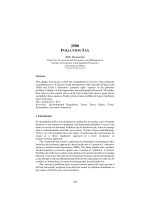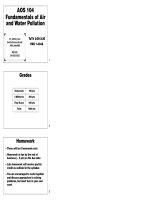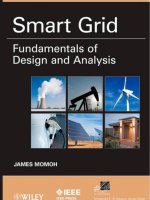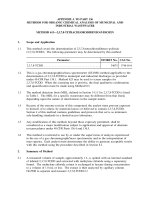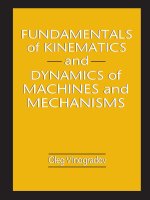FUNDAMENTALS OF TURBULENT AND MULTIPHASE COMBUSTION ppt
Bạn đang xem bản rút gọn của tài liệu. Xem và tải ngay bản đầy đủ của tài liệu tại đây (7 MB, 897 trang )
FUNDAMENTALS
OF TURBULENT
AND MULTIPHASE
COMBUSTION
Fundamentals of Turbulent and Multiphase Combustion Kenneth K. Kuo and Ragini Acharya
Copyright © 2012 John Wiley & Sons, Inc.
FUNDAMENTALS
OF TURBULENT
AND MULTIPHASE
COMBUSTION
KENNETH K. KUO
RAGINI ACHARYA
JOHN WILEY & SONS, INC.
This book is printed on acid-free paper.
Copyright © 2012 by John Wiley & Sons, Inc. All rights reserved
Published by John Wiley & Sons, Inc., Hoboken, New Jersey
Published simultaneously in Canada
No part of this publication may be reproduced, stored in a retrieval system, or transmitted in any
form or by any means, electronic, mechanical, photocopying, recording, scanning, or otherwise,
except as permitted under Section 107 or 108 of the 1976 United States Copyright Act, without
either the prior written permission of the Publisher, or authorization through payment of the
appropriate per-copy fee to the Copyright Clearance Center, 222 Rosewood Drive, Danvers,
MA 01923, (978) 750-8400, fax (978) 646-8600, or on the web at www.copyright.com. Requests
to the Publisher for permission should be addressed to the Permissions Department, John Wiley &
Sons, Inc., 111 River Street, Hoboken, NJ 07030, (201) 748-6011, fax (201) 748-6008, or online at
www.wiley.com/go/permissions.
Limit of Liability/Disclaimer of Warranty: While the publisher and the author have used their best
efforts in preparing this book, they make no representations or warranties with respect to the
accuracy or completeness of the contents of this book and specifically disclaim any implied
warranties of merchantability or fitness for a particular purpose. No warranty may be created or
extended by sales representatives or written sales materials. The advice and strategies contained
herein may not be suitable for your situation. You should consult with a professional where
appropriate. Neither the publisher nor the author shall be liable for damages arising herefrom.
For general information about our other products and services, please contact our Customer Care
Department within the United States at (800) 762-2974, outside the United States at (317)
572-3993 or fax (317) 572-4002.
Wiley publishes in a variety of print and electronic formats and by print-on-demand. Some material
included with standard print versions of this book may not be included in e-books or in
print-on-demand. If this book refers to media such as a CD or DVD that is not included in the
version you purchased, you may download this material at . For more
information about Wiley products, visit www.wiley.com.
Library of Congress Cataloging-in-Publication Data:
Kuo, Kenneth K.
KuFundamentals of turbulent and multiphase combustion / Kenneth K. Kuo,
Ragini Acharya. — 1st ed.
Ragini p. cm.
RaIncludes bibliographical references and index.
RagiISBN 978-0-470-22622-3 (hardback); 978-111-8-09929-2 (ebk.); 978-111-8-09931-5 (ebk.);
978-111-8-09932-2 (ebk.); 978-111-8-10767-6 (ebk.); 978-111-8-10768-3 (ebk.);
978-111-8-10770-6 (ebk.)
R1. Combustion engineering. 2. Turbulence. 3. Combustion—Mathematical models. I. Acharya,
Ragini. II. Acharya, Ragini. III. Title.
RaQD516.K858 2012
Ra541
.361—dc23
2011024787
ISBN: 978-0-470-22622-3
Printed in the United States of America
10987654321
Ken Kuo would like to dedicate this book to his wife, Olivia (Jeon-lin), and their
daughters, Phyllis and Angela, for their love, understanding, patience, and
support, and to his mother, Mrs. Wen-Chen Kuo, for her love and
encouragement.
Ragini Acharya would like to dedicate this book to her parents, Meenakshi and
Krishnama Acharya, for their love, patience, and support and for having endless
faith in her.
CONTENTS
Preface xix
1 Introduction and Conservation Equations 1
1.1 Why Is Turbulent and Multiphase Combustion
Important?, 3
1.2 Different Applications for Turbulent and Multiphase
Combustion, 3
1.2.1 Applications in High Rates of Combustion of
Materials for Propulsion Systems, 5
1.2.2 Applications in Power Generation, 7
1.2.3 Applications in Process Industry, 7
1.2.4 Applications in Household and Industrial Heating, 7
1.2.5 Applications in Safety Protections for Unwanted
Combustion, 7
1.2.6 Applications in Ignition of Various Combustible
Materials, 8
1.2.7 Applications in Emission Control of Combustion
Products, 8
1.2.8 Applications in Active Control of Combustion
Processes, 8
1.3 Objectives of Combustion Modeling, 8
1.4 Combustion-Related Constituent Disciplines, 9
1.5 General Approach for Solving Combustion Problems, 9
vii
viii CONTENTS
1.6 Governing Equations for Combustion Models, 11
1.6.1 Conservation Equations, 11
1.6.2 Transport Equations, 11
1.6.3 Common Assumptions Made in Combustion
Models, 11
1.6.4 Equation of State, 12
1.6.4.1 High-Pressure Correction, 13
1.7 Definitions of Concentrations, 14
1.8 Definitions of Energy and Enthalpy Forms, 16
1.9 Velocities of Chemical Species, 19
1.9.1 Definitions of Absolute and Relative Mass and
Molar Fluxes, 20
1.10 Dimensionless Numbers, 23
1.11 Derivation of Species Mass Conservation Equation and
Continuity Equation for Multicomponent Mixtures, 23
1.12 Momentum Conservation Equation for Mixture, 29
1.13 Energy Conservation Equation for Multicomponent
Mixture, 33
1.14 Total Unknowns versus Governing Equations, 40
Homework Problems, 41
2 Laminar Premixed Flames 43
2.1 Basic Structure of One-Dimensional Premixed Laminar
Flames, 46
2.2 Conservation Equations for One-Dimensional Premixed
Laminar Flames, 47
2.2.1 Various Models for Diffusion Velocities, 49
2.2.1.1 Multicomponent Diffusion Velocities
(First-Order Approximation), 49
2.2.1.2 Various Models for Describing Source
Terms due to Chemical Reactions, 54
2.2.2 Sensitivity Analysis, 66
2.3 Analytical Relationships for Premixed Laminar Flames
with a Global Reaction, 68
2.3.1 Three Analysis Procedures for Premixed Laminar
Flames, 77
2.3.2 Generalized Expression for Laminar Flame
Speeds, 80
2.3.2.1 Reduced Reaction Mechanism for HC-Air
Flame, 81
CONTENTS ix
2.3.3 Dependency of Laminar Flame Speed on
Temperature and Pressure, 82
2.3.4 Premixed Laminar Flame Thickness, 84
2.4 Effect of Flame Stretch on Laminar Flame Speed, 86
2.4.1 Definitions of Stretch Factor and Karlovitz
Number, 86
2.4.2 Governing Equation for Premixed Laminar Flame
Surface Area, 94
2.4.3 Determination of Unstretched Premixed Laminar
Flame Speeds and Markstein Lengths, 95
2.5 Modeling of Soot Formation in Laminar Premixed
Flames, 103
2.5.1 Reaction Mechanisms for Soot Formation and
Oxidation, 104
2.5.1.1 Empirical Models for Soot
Formation, 106
2.5.1.2 Detailed Models for Soot Formation and
Oxidation, 108
2.5.1.3 Formation of Aromatics, 109
2.5.1.4 Growth of Aromatics, 110
2.5.1.5 Migration Reactions, 112
2.5.1.6 Oxidation of Aromatics, 113
2.5.2 Mathematical Formulation of Soot Formation
Model, 114
Homework Problems, 124
3 Laminar Non-Premixed Flames 125
3.1 Basic Structure of Non-Premixed Laminar Flames, 128
3.2 Flame Sheet Model, 129
3.3 Mixture Fraction Definition and Examples, 130
3.3.1 Balance Equations for Element Mass Fractions, 134
3.3.2 Temperature-Mixture Fraction Relationship, 138
3.4 Flamelet Structure of a Diffusion Flame, 142
3.4.1 Physical Significance of the Instantaneous Scalar
Dissipation Rate, 145
3.4.2 Steady-State Combustion and Critical Scalar
Dissipation Rate, 147
3.5 Time and Length Scales in Diffusion Flames, 151
3.6 Examples of Laminar Diffusion Flames, 153
3.6.1 Unsteady Mixing Layer, 153
x CONTENTS
3.6.2 Counterflow Diffusion Flames, 155
3.6.3 Coflow Diffusion Flame or Jet Flames, 165
3.7 Soot Formation in Laminar Diffusion Flames, 172
3.7.1 Soot Formation Model, 173
3.7.1.1 Particle Inception, 174
3.7.1.2 Surface Growth and Oxidation, 174
3.7.2 Appearance of Soot, 175
3.7.3 Experimental Studies by Using Coflow
Burners, 176
3.7.3.1 Sooting Zone, 178
3.7.3.2 Effect of Fuel Structure, 182
3.7.3.3 Influence of Additives, 183
3.7.3.4 Coflow Ethylene/Air Laminar Diffusion
Flames, 186
3.7.3.5 Modeling of Soot Formation, 191
Homework Problems, 204
4 Background in Turbulent Flows 206
4.1 Characteristics of Turbulent Flows, 210
4.1.1 Some Pictures, 212
4.2 Statistical Understanding of Turbulence, 213
4.2.1 Ensemble Averaging, 214
4.2.2 Time Averaging, 215
4.2.3 Spatial Averaging, 215
4.2.4 Statistical Moments, 215
4.2.5 Homogeneous Turbulence, 216
4.2.6 Isotropic Turbulence, 217
4.3 Conventional Averaging Methods, 217
4.3.1 Reynolds Averaging, 218
4.3.1.1 Correlation Functions, 222
4.3.2 Favre Averaging, 225
4.3.3 Relation between Time Averaged-Quantities and
Mass-Weighted Averaged Quantities, 227
4.3.4 Mass-Weighted Conservation and Transport
Equations, 228
4.3.4.1 Continuity and Momentum
Equations, 228
4.3.4.2 Energy Equation, 230
4.3.4.3 Mean Kinetic Energy Equation, 231
CONTENTS xi
4.3.4.4 Reynolds-Stress Transport Equations, 232
4.3.4.5 Turbulence-Kinetic-Energy Equation, 234
4.3.4.6 Turbulent Dissipation Rate Equation, 236
4.3.4.7 Species Mass Conservation
Equation, 242
4.3.5 Vorticity Equation, 243
4.3.6 Relationship between Enstrophy and the Turbulent
Dissipation Rate, 246
4.4 Turbulence Models, 247
4.5 Probability Density Function, 249
4.5.1 Distribution Function, 250
4.5.2 Joint Probability Density Function, 252
4.5.3 Bayes’ Theorem, 254
4.6 Turbulent Scales, 256
4.6.1 Comment on Kolmogorov Hypotheses, 260
4.7 Large Eddy Simulation, 266
4.7.1 Filtering, 268
4.7.2 Filtered Momentum Equations and Subgrid Scale
Stresses, 270
4.7.3 Modeling of Subgrid-Scale Stress Tensors, 274
4.8 Direct Numerical Simulation, 279
Homework Problems, 280
5 Turbulent Premixed Flames 283
5.1 Physical Interpretation, 289
5.2 Some Early Studies in Correlation Development, 291
5.2.1 Damk
¨
ohler’s Analysis (1940), 292
5.2.2 Schelkin’s Analysis (1943), 295
5.2.3 Karlovitz, Denniston, and Wells’s Analysis
(1951), 296
5.2.4 Summerfield’s Analysis (1955), 297
5.2.5 Kovasznay’s Characteristic Time Approach
(1956), 298
5.2.6 Limitations of the Preceding Approaches, 299
5.3 Characteristic Scale of Wrinkles in Turbulent Premixed
Flames, 304
5.3.1 Schlieren Photographs, 305
5.3.2 Observations on the Structure of Wrinkled Laminar
Flames, 305
xii CONTENTS
5.3.3 Measurements of Scales of Unburned and Burned
Gas Lumps, 307
5.3.4 Length Scale of Wrinkles, 310
5.4 Development of Borghi Diagram for Premixed Turbulent
Flames, 310
5.4.1 Physical Interpretation of Various Regimes in
Borghi’s Diagram, 311
5.4.1.1 Wrinkled Flame Regime, 311
5.4.1.2 Wrinkled Flame with Pockets Regime
(also Called Corrugated Flame
Regime), 311
5.4.1.3 Thickened Wrinkled Flames, 313
5.4.1.4 Thickened Flames with Possible
Extinctions/Thick Flames, 314
5.4.2 Klimov-Williams Criterion, 314
5.4.3 Construction of Borghi Diagram, 316
5.4.3.1 Thick Flames (or Distributed Reaction
Zone or Well-Stirred Reaction Zone), 318
5.4.4 Wrinkled Flames, 318
5.4.4.1 Wrinkled Flamelets (Weak
Turbulence), 320
5.4.4.2 Corrugated Flamelets (Strong
Turbulence), 322
5.5 Measurements in Premixed Turbulent Flames, 324
5.6 Eddy-Break-up Model, 324
5.6.1 Spalding’s EBU Model, 335
5.6.2 Magnussen and Hjertager’s EBU Model, 336
5.7 Intermittency, 337
5.8 Flame-Turbulence Interaction, 339
5.8.1 Effects of Flame on Turbulence, 341
5.9 Bray-Moss-Libby Model, 342
5.9.1 Governing Equations, 349
5.9.2 Gradient Transport, 353
5.9.3 Countergradient Transport, 354
5.9.4 Closure of Transport Terms, 357
5.9.4.1 Gradient Closure, 357
5.9.4.2 BML Closure, 358
5.9.5 Effect of Pressure Fluctuations Gradients, 361
5.9.6 Summary of DNS Results, 364
5.10 Turbulent Combustion Modeling Approaches, 368
CONTENTS xiii
5.11 Geometrical Description of Turbulent Premixed Flames and
G-Equation, 368
5.11.1 Level Set Approach for the Corrugated Flamelets
Regime, 371
5.11.2 Level Set Approach for the Thin Reaction Zone
Regime, 374
5.12 Scales in Turbulent Combustion, 376
5.13 Closure of Chemical Reaction Source Term, 380
5.14 Probability Density Function Approach to Turbulent
Combustion, 381
5.14.1 Derivation of the Transport Equation for Probability
Density Function, 386
5.14.2 Moment Equations and PDF Equations, 391
5.14.3 Lagrangian Equations for Fluid Particles, 392
5.14.4 Gradient Transport Model in Composition PDF
Method, 395
5.14.5 Determination of Overall Reaction Rate, 397
5.14.6 Lagrangian Monte Carlo Particle Methods, 398
5.14.7 Filtered Density Function Approach, 398
5.14.8 Prospect of PDF Methods, 399
Homework Problems, 400
Project No. 1, 400
Project No. 2, 401
6 Non-premixed Turbulent Flames 402
6.1 Major Issues in Non-premixed Turbulent Flames, 404
6.2 Turbulent Damk
¨
ohler number, 406
6.3 Turbulent Reynolds Number, 407
6.4 Scales in Non-premixed Turbulent Flames, 407
6.4.1 Direct Numerical Simulation and Scales, 411
6.5 Turbulent Non-premixed Combustion Regime
Diagram, 414
6.6 Turbulent Non-premixed Target Flames, 418
6.6.1 Simple Jet Flames, 419
6.6.1.1 CH
4
/H
2
/N
2
Jet Flame, 420
6.6.1.2 Effect of Jet Velocity, 430
6.6.2 Piloted Jet Flames, 432
6.6.2.1 Comparison of Simple Jet Flame and
Sandia Flames D and F, 448
xiv CONTENTS
6.6.3 Bluff Body Flames, 452
6.6.4 Swirl Stabilized Flames, 455
6.7 Turbulence-Chemistry Interaction, 456
6.7.1 Infinite Chemistry Assumption, 456
6.7.1.1 Unity Lewis Number, 457
6.7.1.2 Nonunity Lewis Number, 458
6.7.2 Finite-Rate Chemistry, 458
6.8 Probability Density Approach for Turbulent Non-premixed
Combustion, 462
6.8.1 Physical Models, 465
6.8.2 Turbulent Transport in Velocity-Composition Pdf
Methods, 466
6.8.2.1 Stochastic Mixing Model, 467
6.8.2.2 Stochastic Reorientation Model, 468
6.8.3 Molecular Transport and Scalar Mixing
Models, 469
6.8.3.1 Interaction by Exchange with the Mean
Model, 471
6.8.3.2 Modified Curl Mixing Model, 471
6.8.3.3 Euclidean Minimum Spanning Tree
Model, 472
6.9 Flamelet Models, 476
6.9.1 Laminar Flamelet Assumption, 477
6.9.2 Unsteady Flamelet Modeling, 478
6.9.3 Flamelet Models and PDF, 479
6.10 Interactions of Flame and Vortices, 480
6.10.1 Flame Rolled Up in a Single Vortex, 482
6.10.2 Flame in a Shear Layer, 483
6.10.3 Jet Flames, 483
6.10.4 K
´
arm
´
an Vortex Street/V-Shaped Flame
Interaction, 484
6.10.5 Burning Vortex Ring, 484
6.10.6 Head-on Flame/Vortex Interaction, 485
6.10.7 Experimental Setups for Flame/Vortex Interaction
Studies, 486
6.10.7.1 Reaction Front/Vortex Interaction in
Liquids, 486
6.10.7.2 Jet Flames, 487
6.10.7.3 Counterflow Diffusion Flames, 488
6.11 Generation and Dissipation of Vorticity Effects, 492
CONTENTS xv
6.12 Non-premixed Flame–Vortex Interaction Combustion
Diagram, 493
6.13 Flame Instability in Non-premixed Turbulent Flames, 496
6.14 Partially Premixed Flames or Edge Flames, 500
6.14.1 Formation of Edge Flames, 501
6.14.2 Triple Flame Stabilization of Lifted Diffusion
Flame, 502
6.14.3 Analysis of Edge Flames, 503
Homework Problems, 506
Project No. 6.1, 506
Project No. 6.2, 507
Project No. 6.3, 507
7 Background in Multiphase flows with Reactions 509
7.1 Classification of Multiphase Flow Systems, 512
7.2 Practical Problems Involving Multiphase Systems, 514
7.3 Homogeneous versus Multi-component/Multiphase
Mixtures, 515
7.4 CFD and Multiphase Simulation, 516
7.5 Averaging Methods, 520
7.5.1 Eulerian Average—Eulerian Mean Values, 522
7.5.2 Lagrangian Average—Lagrangian Mean Values, 523
7.5.3 Boltzmann Statistical Average, 524
7.5.4 Anderson and Jackson’s Averaging for Dense
Fluidized Beds, 525
7.6 Local Instant Formulation, 533
7.7 Eulerian-Eulerian Modeling, 536
7.7.1 Fluid-Fluid Modeling, 536
7.7.1.1 Closure Models, 538
7.7.2 Fluid-Solid Modeling, 540
7.7.2.1 Closure Models, 541
7.7.2.2 Dense Particle Flows, 547
7.7.2.3 Dilute Particle Flows, 549
7.8 Eulerian-Lagrangian Modeling, 550
7.8.1 Fluid-Solid Modeling, 551
7.8.1.1 Fluid Phase, 551
7.8.1.2 Solid Phase, 552
7.9 Interfacial Transport (Jump Conditions), 555
xvi CONTENTS
7.10 Interface-Tracking/Capturing, 561
7.10.1 Interface Tracking, 563
7.10.1.1 Markers on Interface (Surface Marker
Techniques), 564
7.10.1.2 Surface-Fitted Method, 567
7.10.2 Interface Capturing, 568
7.10.2.1 Markers in Fluid (MAC
Formulation), 568
7.10.2.2 Volume of Fluid Method, 569
7.11 Discrete Particle Methods, 573
Homework Problems, 575
8 Spray Atomization and Combustion 576
8.1 Introduction to Spray Combustion, 578
8.2 Spray-Combustion Systems, 580
8.3 Fuel Atomization, 582
8.3.1 Injector Types, 582
8.3.2 Atomization Characteristics, 584
8.4 Spray Statistics, 584
8.4.1 Particle Characterization, 584
8.4.2 Distribution Function, 585
8.4.2.1 Logarithmic Probability Distribution
Function, 588
8.4.2.2 Rosin-Rammler Distribution
Function, 588
8.4.2.3 Nukiyama-Tanasawa Distribution
Function, 589
8.4.2.4 Upper-Limit Distribution Function of
Mugele and Evans, 589
8.4.3 Transport Equation of the Distribution
Function, 590
8.4.4 Simplified Spray Combustion Model for Liquid-Fuel
Rocket Engines, 591
8.5 Spray Combustion Characteristics, 594
8.6 Classification of Models Developed for Spray Combustion
Processes, 602
8.6.1 Simple Correlations, 602
8.6.2 Droplet Ballistic Models, 603
8.6.3 One-Dimensional Models, 603
8.6.4 Stirred-Reactor Models, 604
CONTENTS xvii
8.6.5 Locally Homogeneous-Flow Models, 605
8.6.6 Two-Phase-Flow (Dispersed-Flow) Models, 605
8.7 Locally Homogeneous Flow Models, 605
8.7.1 Classification of LHF Models, 606
8.7.2 Mathematical Formulation of LHF Models, 609
8.7.2.1 Basic Assumptions, 609
8.7.2.2 Equation of State, 609
8.7.2.3 Conservation Equations, 615
8.7.2.4 Turbulent Transport Equations, 619
8.7.2.5 Boundary Conditions, 620
8.7.2.6 Solution Procedures, 620
8.7.2.7 Comparison of LHF-Model Predictions
with Experimental Data, 626
8.8 Two-Phase-Flow (Dispersed-Flow) Models, 634
8.8.1 Particle-Source-in-Cell Model (Discrete-Droplet
Model), 637
8.8.1.1 Models for Single Drop Behavior, 639
8.8.2 Drop Breakup Process and Mechanism, 654
8.8.2.1 Drop Breakup Process, 654
8.8.2.2 Multi-component Droplet Breakup by
Microexplosion, 659
8.8.3 Deterministic Discrete Droplet Models, 662
8.8.3.1 Gas-Phase Treatment in DDDMs, 664
8.8.3.2 Liquid-Phase Treatment in DDDMs, 666
8.8.3.3 Results of DDDMs, 667
8.8.4 Stochastic Discrete Droplet Models, 669
8.8.5 Comparison of Results between DDDMs and
SDDMs, 671
8.8.6 Dense Sprays, 682
8.8.6.1 Introduction, 682
8.8.6.2 Background, 684
8.8.6.3 Jet Breakup Models, 690
8.8.6.4 Impinging Jet Atomization, 699
8.9 Group-Combustion Models of Chiu, 700
8.9.1 Group-Combustion Numbers, 701
8.9.2 Modes of Group Burning in Spray Flames, 703
8.10 Droplet Collison, 706
8.10.1 Droplet-Droplet Collisions, 707
8.10.2 Droplet-Wall Collision, 708
8.10.3 Interacting Droplet in a Many-Droplet System, 710
xviii CONTENTS
8.11 Optical Techniques for Particle Size Measurements, 710
8.11.1 Types of Optical Particle Sizing Methods, 711
8.11.2 Single Particle Counting Methods, 711
8.11.2.1 Scattering Ratio Technique, 712
8.11.2.2 Intensity Deconvolution Method, 713
8.11.2.3 Interferometric Method (Phase-Shift
Method), 713
8.11.2.4 Visibility Method Using a Laser Doppler
Velocimeter LDV, 713
8.11.2.5 Phase Doppler Sizing Anemometer, 713
8.11.3 Ensemble Particle Sizing Techniques, 714
8.11.3.1 Extinction Measurement Techniques, 714
8.11.3.2 Multiple Angle Scattering Technique, 714
8.11.3.3 Fraunhofer Diffraction Particle
Analyzer, 715
8.11.3.4 Integral Transform Solutions for
Near-Forward Scattering, 716
8.12 Effect of Droplet Spacing on Spray Combustion, 717
8.12.1 Evaporation and Combustion of Droplet
Arrays, 717
Homework Problems, 720
Appendix A: Useful Vector and Tensor Operations 723
Appendix B: Constants and Conversion Factors Often Used in
Combustion 751
Appendix C: Naming of Hydrocarbons 755
Appendix D: Detailed Gas-Phase Reaction Mechanism for
Aromatics Formation 759
Appendix E: Particle Size–U.S. Sieve Size and Tyler Screen Mesh
Equivalents 795
Bibliography 799
Index 869
PREFACE
There is an ever-increasing need to understand turbulent and multiphase combus-
tion due to their broad application in energy, environment, propulsion, transporta-
tion, industrial safety, and nanotechnology. More engineers and scientists with
skills in these areas are needed to solve many multifaceted problems. Turbulence
itself is one of the most complex problems the scientific community faces. Its
complexity increases with chemical reactions and even more in the presence of
multiphase flows.
A number of useful books have been published recently in the areas of theory
of turbulence, multiphase fluid dynamics, turbulent combustion, and combustion
of propellants. These include Theoretical and Numerical Combustion by Poinsot
and Veynante; Turbulent Flows by Pope; Introduction to Turbulent Flow by
Mathieu and Scott; Turbulent Combustion by Peters; Multiphase Flow Dynamics
by Kolev; Combustion Physics by Law; Fluid Dynamics and Transport of Droplet
and Sprays by Sirignano; Compressible, Turbulence, and High-Speed Flow by
Gatski and Bonnet; Combustion by Glassman and Yetter, among others.
Kenneth Kuo, the first author of this book, previously published Principles of
Combustion. The second edition, published in 2005, contains comprehensive
material on laminar flames, chemical thermodynamics, reaction kinetics, and
transport properties for multicomponent mixtures. As the research in laminar
flames was overwhelming, he decided to develop two separate books dedicated
entirely to turbulent and multiphase combustion.
Turbulence, turbulent combustion, and multiphase reacting flows have been
major research topics for many decades, and research in these areas is expected
to continue at even a greater pace. Usually the research has focused on experi-
mental studies with phenomenological approaches, resulting in the development
of empirical correlations. Theoretical approaches have achieved some degree
of success. However, in the past 20 years, advances in computational capability
xix
xx PREFACE
have enabled significant progress to be made toward comprehensive theoretical
modeling and numerical simulation. Experimental diagnostics, especially
nonintrusive laser-based measurement techniques, have been developed and used
to obtain accurate data, which have been used for model validation. There is a
greater synergy between the experimental and theoretical/numerical approaches.
Due to these ongoing developments and advancements, theoretical modeling and
numerical simulation hold great potential for future solutions of problems. In
these two new books, we have attempted to integrate the fundamental theories of
turbulence, combustion, and multiphase phenomena as well as experimental tech-
niques, so that readers can acquire a firm background in both contemporary and
classical approaches. The first book volume is called Fundamentals of Turbulent
and Multiphase Combustion; the second is called Applications of Turbulent and
Multiphase Combustion. The first volume can serve as a graduate-level textbook
that covers the area of turbulent combustion and multiphase reacting flows as
well as material that builds on these fundamentals. This volume also can be
useful for research purpose. It is oriented toward the theories of combustion,
turbulence, multiphase flows, and turbulent jets. Whenever appropriate,
experimental setups and results are provided. The first volume addresses eight
basic topical areas in combustion and multiphase flows, including laminar
premixed and nonpremixed flames; theory of turbulence; turbulent premixed and
nonpremixed flames; background of multiphase flows; and spray atomization and
combustion. A deep understanding of these topics is necessary for researchers
in the field of combustion.
The six chapters in the second volume build on the ground covered in the
first volume. Its chapters include: solid propellant combustion, thermal decom-
position and combustion of nitramines burning behavior of homogeneous solid
propellants, chemically reacting boundary-layer flows, ignition and combustion of
combustion of single energetic solid particles, and combustion of solid particles
in multiphase flows. The major reason for including solid-propellant combus-
tion here is to provide concepts for condensed-phase combustion modeling as
an example. Nitramines are explosive or propellant ingredients; their decompo-
sition and reaction mechanisms are also good examples for combustion behavior
of condensed-phase materials. Chapters in Volume 2 focus on the application
aspect of fundamental concepts and can form the framework for an advanced
graduate-level course in combustion of condensed-phase materials. However, the
selection of materials for instruction depends extirely on the interests of instruc-
tors and students. Although several chapters address solid propellant combustion,
this volume is not a textbook for solid propellant combustion; many topics in
this area are not included due to space limitations.
VOLUME 1, FUNDAMENTALS OF TURBULENT
AND MULTIPHASE COMBUSTION
Chapter 1 introduces and stresses the importance of combustion and multiphase
flows in research. It also provides a succinct review of major conservation
PREFACE xxi
equations. Appendix A provides the vector and tensor operations frequently used
in the formulation and manipulation of these equations.
Chapter 2 covers the basic structure of laminar premixed flames, conservation
equations, various models for diffusion velocities in a multicomponent gas system
with increasing complexities, laminar flame thickness, asymptotic analyses, and
flame speeds. Effect of flame stretch on laminar flame speed, Karlovitz number,
and Markstein lengths are also discussed in detail along with soot formation in
laminar premixed flames.
Chapter 3 discusses the basic structure of laminar nonpremixed flames and
provides detailed descriptions of mixture fraction definition, balance equations
for mixture fraction, temperature-mixture fraction relationship, and examples,
since mixture fraction is a very important parameter in the study of nonpremixed
flames. The chapter also discusses laminar flamelet structure and equations, crit-
ical scalar dissipation rate, steady-state combustion, and examples of laminar
diffusion flames with equations and solutions. Since pollution, specifically soot
formation, has become a major topic of interest, it is also covered in this chapter
with respect to laminar diffusion flames. Appendix D provides a detailed soot for-
mation mechanism and rate constants that was proposed by Wang and Frenklach.
Chapter 4 is devoted entirely to turbulent flows. It covers the fundamental
understanding of turbulence from a statistical point of view; homogeneous and/or
isotropic turbulence, averaging procedures, statistical moments, and correlation
functions; Kolmogorov hypotheses; turbulent scales; filtering and large-eddy
simulation (LES) concepts along with various subgrid scale models; and basic
definitions to prepare readers for the probability density function (pdf) approach
in later chapters. This chapter also includes the governing equations for com-
pressible flows. A short introduction of the direct numerical simulation (DNS)
approach is also provided at the end of the chapter.
Chapters 5 and 6 focus on the turbulent premixed and nonpremixed flames,
respectively. Chapter 5 consists of physical interpretation; studies for turbulent
flame-speed correlation development; Borghi diagram and physical interpretation
of various regimes; eddy breakup models; measurements in premixed turbulent
flames; flame-turbulence interaction (effects of turbulence on flame as well as
effect of flame on turbulence); turbulence combustion modeling approaches;
Bray-Moss-Libby model (gradient and counter-gradient transport); level set
approach and G-equation for flame surfaces; and the pdf approach and closure
of chemical reaction source term. In Chapter 6, the discussion focuses on major
problems in nonpremixed turbulent combustion; turbulent Damk
¨
ohler number
and Reynolds number; scales in nonpremixed turbulent flames; regime diagrams;
target flames; turbulence-chemistry interaction; pdf approach; flamelet models;
flame-vortex interaction; flame instability; partially premixed flames; and edge
flames.
The fundamentals of multiphase flows are covered in Chapter 7, which has
sections on classification of multiphase flows; homogeneous versus multiphase
mixtures; averaging methods; local instant formulation; Eulerian-Eulerian mod-
eling; Eulerian-Lagrangian modeling; interface transport (tracking and capturing)
xxii PREFACE
methods (volume of fluid, surface fitted method, markers on interface); and dis-
crete particle methods. This chapter also provides many contemporary approaches
for modeling two-phase flows.
Spray combustion is an extremely important topic for combustion, and Chapter
8 provides a comprehensive account of various modeling approaches to spray
combustion associated with single drop behavior, drop breakup mechanisms, jet
breakup models, group combustion models, droplet-droplet collisions, and dense
sprays. Experimental approaches and results are also presented in this chapter.
VOLUME 2, APPLICATIONS OF TURBULENT
AND MULTIPHASE COMBUSTION
Chapter 1 provides a background in solid propellants and their combustion
behavior, including desirable characteristics; oxygen balance; homogeneous and
heterogeneous propellants; fuel binders, oxidizer ingredients, curing and cross-
linking agents, and aging; hazard classifications; material characterization of solid
propellants; and gun performance parameters including thrust, specific impulse,
and stable/unstable burning behavior.
Chapter 2 focuses on nitramine decomposition and combustion; phase trans-
formation; and three different approaches for thermal decomposition of royal
demolition explosive (RDX) as well as gas-phase reactions. This chapter also
describes a modeling approach for RDX combustion.
Chapter 3 covers the burning behavior of homogeneous (e.g., double-base) pro-
pellants, describing both the experimental and modeling approaches to study and
predict the burning rate and temperature sensitivities of common solid propellants.
The transient burning characteristics of a typical homogeneous propellant is also
presented in detail, including the Zel’dovich map technique and the Novozhilov
stability parameters.
Chapter 4 covers reacting turbulent boundary-layer flows, a topic of research
for the last six decades. The chapter discusses the modeling approaches from
1940s to the current date. Graphite nozzle erosion process by high-temperature
combustion product gases through heterogeneous chemical reactions is covered
in detail. Turbulent wall fires are also covered.
Chapter 5 contains the ignition and combustion studies of single energetic
particles (such as micron-size boron and aluminum particles) including mul-
tistage combustion models for cases with and without the presence of oxide
layers, kinetic mechanisms, criterion for diffusion-controlled combustion versus,
kinetic controlled combustion, effect of oxidizers (such as oxygen- and fluorine-
containing species), combustion of nano-size energetic particles, and their strong
dependency on kinetic rates.
Chapter 6 addresses the two-phase reacting flow simulation and focuses on
granular bed combustion with different solution techniques for the governing
equations. It also includes experimental validation of the calculated results.
We would like to acknowledge the contributions of many of our combustion
and turbulence colleagues for reviewing and providing a critical assessment
PREFACE xxiii
of multiple chapters of these volumes includes Professor Forman A. Williams
of the University of California-San Diego; Professor Stephen B. Pope, Cornell
University; Dr. Richard Behrens, Jr. of Sandia National Laboratory; Dr.
William R. Anderson of the U.S. Army Research Laboratory; Professor Luigi
T. DeLuca of Politecnico di Milano, Italy; and Professors James G. Brasseur,
Daniel C. Haworth, and Michael M. Micci of Pennsylvania State University.
They spent their valuable time reading chapters and helped us to improve the
material covered in Volume 1 and Volume 2. We also want to thank Professor
Michael Frenklach of University of California-Berkeley for providing us the
detailed information on soot formation kinetics used in Appendix D of Volume
1. We also like to thank Professor William A. Sirignano of University of
California-Irvine for his valuable input on evaporation and combustion of
droplet arrays. Professor Norbert Peters of the Institut f
¨
ur Technische Mechanik
of Aachen, Germany, was very geneous to provide his book draft to Kenneth
Kuo while he was visiting the Pennsylvania State University. His notes were
very helpful in explaining turbulent combustion topics.
During the sabbatical leave of the first author at the U.S. Army Research Lab
(ARL), Dr. Brad E. Forch of ARL and Dr. Ralph A. Anthenien Jr. of the Army
Research Office (ARO) hosted and supported a series of his lectures. The lecture
materials, which we prepared jointly, were used in the development of several
chapters of Volume 2. We greatly appreciate the encouragement and support of
Dr. Forch and Dr. Anthenien.
Kenneth Kuo would like to take this opportunity to thank his many research
project sponsors, since his in-depth understanding of many topics in turbulent and
multiphase combustion has been acquired through multi-year research. These
sponsors include: Drs. Richard S. Miller, Judah Goldwasser, and Clifford D.
Bedford of ONR of the U.S. Navy; Drs. David M. Mann, Robert W. Shaw, Ralph
A. Anthenien, Jr. of ARO; Dr. Martin S. Miller of ARL; Mr. Carl Gotzmer of
NSWC-Indian Head; Dr. Rich Bowen of NAVSEA of the US Navy, Drs. William
H. Wilson and Suhithi Peiris of the Defense Threat Reduction Agency (DTRA);
and Drs. Jeff Rybak, Claudia Meyer, and Matthew Cross of NASA. The authors
would like to thank Mr. Henry T. Rand of ARDEC and Mr. Jack Sacco of Savit
Corporation for sponsoring our project on granular propellant combustion.
Ragini Acharya would like to thank several professors at The Pennsylvania
State University for developing the framework and knowledge base to aid her in
writing the book manuscript, including Professors Andr
´
e L. Boehman, James G.
Brasseur, John H. Mahaffy, Daniel C. Haworth, and Richard A. Yetter.
We both would like to acknowledge the generosity of Professor Peyman Givi
of the University of Pittsburgh for granting us full permission to use some of his
numerical simulation results of RANS, LES, and DNS of a turbulent jet flame
on the jacket of Volume 1. For the cover of Volume 2, we would like to thank
Dr. Larry P. Goss of Innovative Scientific Solutions, Inc and Dr. J. Eric Boyer
of the High Pressure Combustion Lab of PSU for the photograph of metalized
propellant combustion. Also, Professor Luigi De Luca and his colleagues Dr.
Filippo Maggi at the Polytechnic Institute of Milan for granting the permission to
xxiv PREFACE
use their close-up photographs of the burning surface region of metallized solid
propellants, showing the dynamic motion of the burning of aluminum/Al
2
O
3
particles.
We would also like to thank Ms. Petek Jinkins and Ms. Aqsa Ahmed for
typing references, preliminary proofreading, and miscellaneous help with the
preparation of the manuscript. We also want to thank John Wiley & Sons for
their patience and cooperation. Last but not least, we also would like to thank
our family members for their sacrifice during the long and difficult process of
manuscript preparation.
Kenneth K. Kuo and Ragini Acharya
University Park, Pennsylvania
1
INTRODUCTION AND
CONSERVATION EQUATIONS
SYMBOLS
Symbol Description Dimension
B
i
Body force per unit volume in i-direction (vector) F/L
3
C Molar concentration N/L
3
C
i
Molar concentration of the i
th
species N/L
3
d Molecular diameter L
D
Ab
Binary mass diffusivity for A-B system L
2
/t
e
ij
Strain rate tensor t
−1
Ea
k
Activation energy for the kth reaction Q/N
f
i
External force per unit mass on species i (vector) F/M
F Force (vector) F
F
S
Surface force (vector) F
h Enthalpy per unit mass Q/M
h
t
Total enthalpy per unit mass Q/M
I Identity matrix or vector form of Kronecker delta
δ
ij
–
J
i
Mass flux of species i relative to mass-average
velocity (vector)
M/L
2
t
J
∗
i
Molar flux of species i relative to molar-average
velocity (vector)
N/L
2
t
K Boltzmann constant (Q/T)/molecule
1
Fundamentals of Turbulent and Multiphase Combustion Kenneth K. Kuo and Ragini Acharya
Copyright © 2012 John Wiley & Sons, Inc.
2 INTRODUCTION AND CONSERVATION EQUATIONS
Symbol Description Dimension
l Mean free path L
˙
m Mass flux (vector) M/L
2
t
m
i
Mass of the i
th
species in the mixture M
m
t
Total mass of a multi component gaseous mixture M
Mw
i
Molecular weight of i
th
species M/N
˙
n Molar flux (vector) NL
2
t
n
i
Number of moles of i
th
species in the gaseous
mixture
N
N
i
Number of moles of species i —
N
A
Avogadro’s number, 6.02252 × 10
23
molecules/mole
–
q Heat-flux vector (vector) Q/L
2
t
T
◦
Fixed standard reference temperature, at 298.15 K T
u Arithmetic-mean molecular speed L/t
u
i
Velocity component in i
th
-direction L/t
v Mass-average velocity (vector) L/t
V Control volume L
3
v
i
Velocity of i
th
species with respect to stationary
coordinate axes (vector)
L/t
ν
∗
Molar-average velocity (vector) L/t
V
i
Mass diffusion velocity of i
th
species (vector) L/t
V
∗
i
Molar diffusion velocity of i
th
species (vector) L/t
X
i
Mole fraction of the i
th
species —
y Space coordinate in y-direction L
Y
i
Mass fraction of the i
th
species —
z Space coordination in z -direction L
Z Frequency of molecular collisions of gaseous
species per unit surface area
L
−2
t
−1
Greek Symbols
α Thermal diffusivity L
2
/t
α
i
Thermal diffusion coefficient for species i L
2
/t
l Thermal conductivity or second viscosity Q/tLT or Ft/L
2
μ Dynamic viscosity or first viscosity Ft/L
2
μ
Bulk viscosity Ft/L
2
μ
ij
Reduced mass of molecules of species i and j M
σ
ij
,
˜
σ Total stress tensor F/L
2
τ
ij
Viscous stress tensor F/L
2
˙
i
Molar rate or production of species i N/(tL
3
)
˙ω
i
Mass rate of production of species i M/(tL
3
)
DIFFERENT APPLICATIONS FOR TURBULENT AND MULTIPHASE COMBUSTION 3
This chapter first discusses turbulent and multiphase combustion as a major
area of research for understanding and importance of solution of multiple chal-
lenging and interesting problems related to energy, environment, transportation,
and chemical propulsion, among other fields. The second topic provides a sum-
mary of the major conservation equations used by researchers in the combustion
community.
1.1 WHY IS TURBULENT AND MULTIPHASE COMBUSTION
IMPORTANT?
Currently, a very high percentage (∼80%) of energy is generated by combustion
of liquids (such as gasoline and hydrocarbon fuels), solids (such as coal and
wood), and gases (such as natural gas composed of largely methane and other
hydrocarbons like ethane, propane, butanes and pentanes). For example, during
the first decades of the twenty-first century more than 50% of the electricity in
the United States was generated by coal-fired furnaces. This trend is expected to
continue for several decades. Thus, energy generation will continue to rely heavily
on combustion technology. Most practical devices involve turbulent combustion,
which requires understanding of both turbulence and combustion, as well as their
effects on each other. Industrial furnaces, diesel engines, liquid rocket engines,
and devices using solid propellants involve multiphase and turbulent combustion.
Single-phase turbulent reacting flows are complicated enough for modeling and
numerical solutions, some of these flows are still unresolved problems of our
time. The complexity of the problem increases even further with the presence of
multiple phases.
In recent years, there has been a greater move to increase combustion effi-
ciency while keeping the emissions level as low as possible. We live in times in
which energy has become a very critical commodity. Therefore, it is important
that the unresolved problems of combustion should be understood and solved.
Well-trained combustion engineers and scientists are needed to engage in numer-
ous challenging combustion problems. This chapter provides some general back-
ground about the applications of turbulent and multiphase combustion, the general
concept of modeling, and basic conservation equations for gas-phase mixtures
containing multiple species.
1.2 DIFFERENT APPLICATIONS FOR TURBULENT
AND MULTIPHASE COMBUSTION
There are various applications of turbulent and multiphase combustion associated
closely with our daily life. Some of these are:
• Power generation from combustion (one example of two-phase turbulent
combustion used for energy generation from coal-fired burners can be seen
in Figure 1.1)

